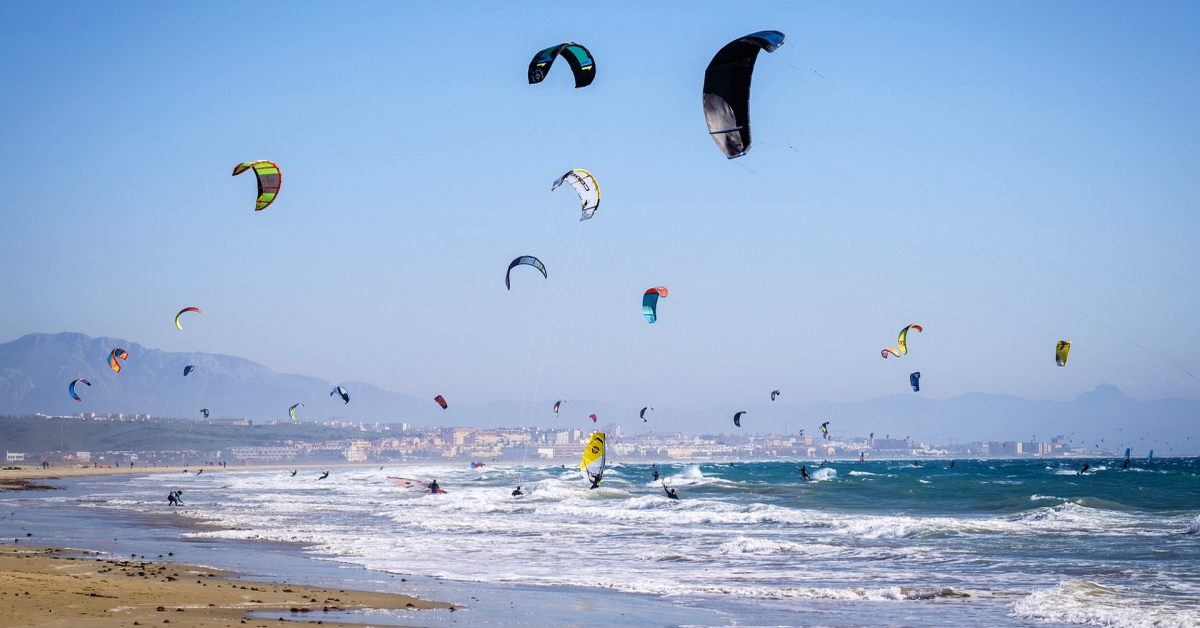Embark on the exhilarating journey of kite sailing, a dynamic blend of surfing, windsurfing, and aerial acrobatics, powered by the wind and your desire for adventure. This concise guide is your ticket to understanding and mastering the essentials of kite sailing, ensuring you’re equipped for an unforgettable experience on the waves in 2024.
With the sport’s rising popularity and potential Olympic debut, there’s never been a better time to harness the breeze and ride confidently. Whether you’re a seasoned sailor or a curious newcomer, discover the equipment, techniques, and safety tips to transform the wind into your most trusted ally on the water.
Join me as I unveil the secrets to mastering kite sailing, your next wave-riding thrill!
Basics of Kite Sailing
Kite sailing captivated me the first time I caught the wind filling up the kite’s fabric, lifting the board and sweeping me across the water. Its fusion of power and grace makes learning the fundamentals challenging and rewarding.
Equipment and Gear
Before setting sail, it’s critical to be equipped with the right gear. The kite, your primary tool, comes in various shapes, including leading-edge inflatables and foil kites, each offering different levels of stability and pulling power. Your harness connects you to the kite, while the control bar and lines act as your steering wheel. Don’t forget the board under your feet; options range from twin tips for freestyle to directional boards for wave riding. For lift and control, pay close attention to the sail area and mast height, which contribute to your overall experience.
Learning to Kite Sail
To learn more about kite sailing, starting with a lesson from a certified instructor is key. You’ll begin by understanding how to deploy and control the power kite, building the skills to manage wind direction and line tension. Learning to launch and land safely is also crucial. As you progress, you’ll practice on the water, mastering how to stand on the board with foot straps, how to navigate through waves, and how to use the kite’s power to paddle without actually paddling.
Safety Measures
Safety cannot be overstated in kite sailing. Always wear a life jacket and helmet, and use a winder to tidy your lines. Learn and abide by the right-of-way rules to avoid collisions. Understand how to react if you capsize or need to detangle lines. Weather awareness is also essential; avoid strong winds and storms that can make waves treacherous. Lastly, always have a safety release system in place which allows you to detach from the kite quickly in case of emergency.
Advancements in Kite Sailing

Kite sailing has seen a wealth of innovation, impacting the performance and popularity of the sport. Let’s explore the specific advances defining this thrilling water activity’s modern era.
Modern Designs and Technology
I’ve observed that the latest foil kites have genuinely elevated the sport of kiteboarding. Unlike their predecessors, these kites are designed for optimal lift and greater stability and control in various wind conditions. The materials are more lightweight and durable, significantly boosting performance. Notably, advancements in GPS technology have allowed for precise tracking of speed and upwind capability, enhancing safety and performance metrics.
A notable technological leap has been the introduction of the Seawing, a kite that propels vessels across the ocean using computer-controlled kites for fuel efficiency and power. This advancement exhibits the potential crossover between recreational kite sailing and the maritime industry.
Competitive Kite Sailing
Kite sailing is no longer just a leisure activity; it has transformed into a highly competitive sport. The races are thrilling to watch, as men and women navigate through waves, aggressively cutting upwind and gliding downwind at impressive speeds.
Hydrofoil technology – a foil attached to a daggerboard – allows boards to rise above the water, reducing drag and enabling incredibly high speeds. Competitive kite sailing events are increasingly prominent, drawing crowds and sparking a surging interest in the sport.
The Global Kite Sailing Community
The kite sailing community has expanded globally, largely thanks to the sharing of techniques, experiences, and pictures through online forums and social media. Numerous schools and programs have popped up along coastlines, enthusiastically welcoming newcomers interested in learning the sport.
There’s a shared sense of camaraderie as experienced kite sailors mentor novices, helping them to progress from struggling with light breezes to confidently riding the beam reach and tackling golden sunsets. The community’s spirit is contagious and fosters a welcoming environment for both men and women to enjoy the freedom of kite sailing.
FAQ – Kite Sailing

Kite sailing is thrilling, but it comes with questions like any watersport. Let me help clarify some everyday curiosities.
What are the disadvantages of kitesurfing?
Learning Curve: Learning the skills needed to kitesurf effectively takes time. Beginners may find balancing, controlling the kite, and reading the water conditions challenging.
Physical Demand: Kitesurfing requires a good level of fitness. It can be taxing on the arms, legs, and core muscles.
Can you fly away while kitesurfing?
Myth Busted: It’s a common fear, but being lifted and flown away is rare when proper techniques are followed. Most kites are designed to keep you safely tethered to the water rather than flying off into the sky.
Can kitesurfers go upwind?
Skills Required: Yes, experienced kitesurfers can sail upwind by performing a technique known as “edging,” which involves angling the board and navigating the kite in a specific pattern to make headway against the wind.
Set sail on the discussion and share your own kite sailing stories and tips in the comments below – let’s navigate the waters of adventure together!









